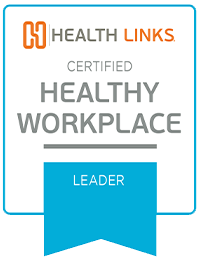
Surrounded by the stunning natural landscape of Colorado’s Rocky Mountains, it is no surprise that Eagle River Water & Sanitation District (ERWSD) understands balance and integration. ERWSD, a local government that provides efficient, reliable water and wastewater service to eastern Eagle County, Colorado, has been a proud Health Links Certified Healthy Workplace™ network member since 2016. The organization gracefully weaves benefits, training, and impactful approaches to employee safety, health, and well-being based on employee feedback.
In the condensed Q&A, we spoke with Tracy Rymph, SHRM, senior people analyst, about what makes ERWSD stand out in its efforts to support employees as individuals. The company’s approach allows it to serve its community safely and with excellence.
We try to take a whole-person approach to employment. We know your health as a person directly affects your ability to deliver for the organization and ultimately the community (because we are a public service). By creating a healthy workplace, we're enriching our employees’ personal and work lives. By championing safety, we’re taking care of the most important aspect of someone’s job – their ability to come home every day safe and sound to enjoy the ones they love.
We spend a third of our lives at work, so we want that third of the time to be a happy and healthy place. A healthy workplace has proven time and time again to be a more productive workplace. A Total Worker Health (TWH) approach leads to better morale, lower turnover, lower absenteeism, and more productivity. People who feel cared for are more engaged, will take care of themselves and others, and further perpetuate that positive work environment that we're trying to create.
Our safety and wellness committee leaders are on the people operations team, so we can organically collaborate. Safety and wellness reviewed our annual calendars to team up on events, initiatives, and communication. Collaboration is built into our plans by ensuring we have a crossover safety and wellness committee meeting, bringing those committees together at least once a year.
In 2022, we won the Health Links Integration Award because it happens so naturally within our organization. We recognize the importance of crossover between the two in terms of TWH. In 2023, we were awarded Safest District of the Year by the Colorado Special Districts Property and Liability Pool, being recognized for our commitment to Safety out of more than 2,000+ special districts.
We try to normalize the conversation about TWH by hosting a variety of well-being seminars on mental health, physical health, nutrition, and financial well-being, among others. We try to host monthly safety and wellness seminars and share content on our intranet.
We also have established discounts for employees throughout the community that promote physical health, including fitness center discounts and pro deals for outdoor gear and exercise equipment. We promote the usage of our Employee Assistance Program (EAP) and encourage reaching out, rather than stigmatizing seeking mental health services. Leaders at every level encourage folks to seek the EAP as a resource and it shows because our usage is about four times the national average.
We have many feedback mechanisms in place to seek feedback and take that seriously into consideration when renewing and seeking our new benefits. We host annual focus groups, often with benefits as a main topic and ask employees about safety, wellness, and benefits in entrance, exit, and stay interviews. We try to take a holistic look at safety and wellness and implement programs that employees find valuable. All the best ideas for these programs have come from employees across the organization.
Our leadership recognizes the importance of, promotes, supports, and participates in wellness events and activities. They give the committees time to work on specific projects for safety and wellness that are outside their normal scope of work. It’s part of all our jobs, it's not just one person's dedication. That approach leads to a culture that really owns our commitment to being safe and well.
And our leaders lead by example. Our leadership participates in “after action” meetings to learn from emergency incidents to make future situations better. They’re held to the same standards as other employees and lead by example by modeling the behavior that's expected.
The Healthy Workplace Assessment® and the advising stand out. The Assessment is a good benchmark tool to see what our strengths are, where opportunities lie, and what other organizations are doing. The other surveys available are good tools for that as well.
I always leave advising sessions with renewed energy to put towards TWH. We get personalized advice and resources that are helpful for things that I don't always have the capacity to gather.
Don't think about the money spent on wellness and safety as an additional expense; think of it as a sound investment. If you have a healthy workplace culture, you will have lower healthcare insurance and workers compensation costs. Employees who feel like their organization cares about their well-being return that dedication and you will see that return on your investment. It's money well spent.
Enlist help from across the organization because those employees work every single day and see things you don't. Enlist the help of others, enlist support from leadership if you don't feel like you have it, and don't feel like you're alone. Use outside resources as well. It cannot be owned by one person. You need to lean on others to create a lasting, healthy workplace culture.




Employee ski day



Trail clean up volunteer day

Lab tie dye day

River water sampling

IT boom lift training